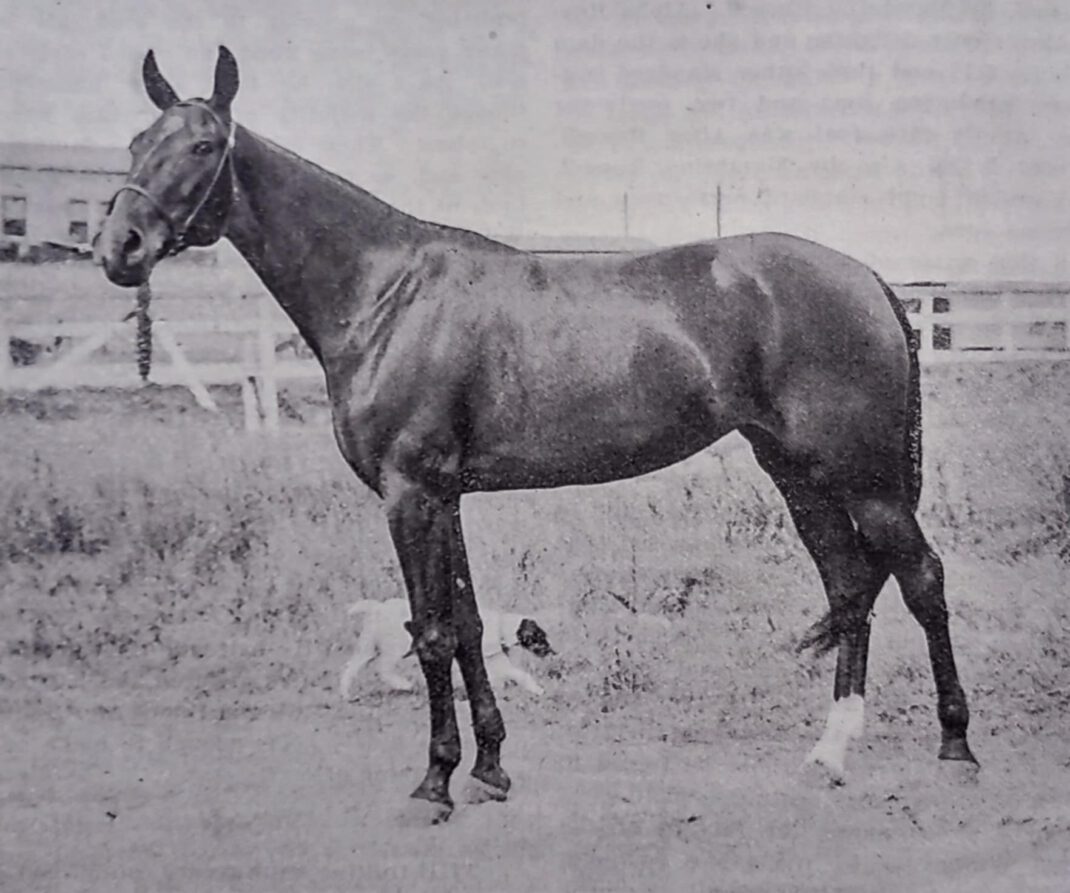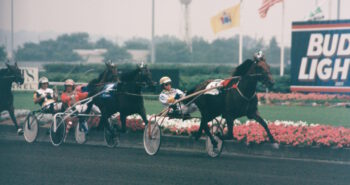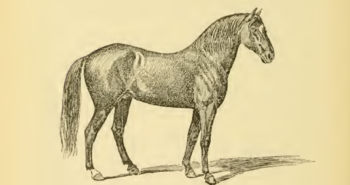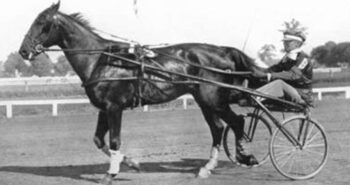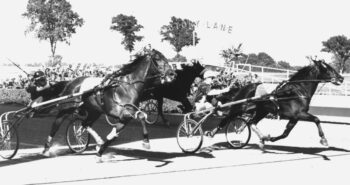She was on her way to possibly becoming one of the best trotters in history when tragedy struck. The tale of Sadie Mac is one a trotter so superior it’s almost unparalleled, but also contains an ending so sad it’s almost incomprehensively.
When John M Johnson of the Calais Stock Farm in Calais, ME in 1899 bought Fanella, in foal to Peter the Great, as well as a colt foal by Bingen by her side, at $500, he was surely hopeful of it being a good deal – but he had no idea what kind of steal it was. The foal became known as Todd. He was a sensation at 2 and trotted eighths in 15 seconds flat (a 1.14,6-speed). It also meant he was paid handsomely for Todd’s one year younger sister, named Miss Todd, who was sold to Lon McDonald and Howland Russell for $4,000. Writes Johnson in the Calais Stud Farm catalogue: “Miss Todd showed as much speed in her yearling form as her half brother. She took the blue ribbon at the Maine State Fair, and awarded the same distinction at the New England Breeders’ Meeting at Readville. The Judges, Messrs Wm Russell Allen and David Bonner, said that the class in which she was exhibited was the best lot of yearling fillies she had ever seen together. I sold Miss Todd to Mr Howland S Russell also for $4,000. The day he bought her she showed an eighth in 18 seconds (a 1.29,5 speed)”
Miss Todd continued her development and McDonald and Russell were offered $7,000 for the untried 2-year-old filly in Apr 1902. That was turned down, but shortly thereafter Russell sold his half for $6,000 to George D Sherman of Port Henry, NY.
That July, the filly was reported to work in 2:24 (1.29,5), the last half in 1:10. According to one article, “all who have seen Miss Todd, the 2-year-old Peter the Great Filly, pronounce her the fastest at the age they ever have seen.” In the middle of the month, she worked out in 2:31 1/2 at Readville, last half in 1:09 1/2, last quarter in 32 1/2, last eighth in 15 1/2 seconds, and was then let up for a few weeks. McDonald was clearly very aware of the filly’s huge talent, but not wanting to rush anything Miss Todd didn’t start at 2.
A new name
In Apr 1903, the filly was entered in numerous 3-year-old stakes under a new name, Sadie Mac, in honor of McDonald’s teenage daughter. She was sometimes, incorrectly, referred to as “Sadie Mc” or “Sadie Mack.”
Though not starting Sadie for a long time, McDonald had clearly trained very well. On Aug 23, 1903, newspapers reported that “if workouts go for anything Lon McDonald has the kingpin of all the 3-year-old trotters in Sadie Mac, a daughter of Peter the Great and Fanella 2:22, by Arion. This filly is a Forbes farm product, both her sire and the sire of her dam being owned there, and was a fast 2-year-old. The other day she stepped the Empire track in 2:13 3/4, 2:12 3/4 (1.23,1 and 1.22,5), the last half of the second mile being done a shade under 1:05 (1.20,8-speed). Like all the other really sensational 3-year-olds this season Sadie Mac is in the Kentucky Futurity, and that race will certainly be a wonder for speed if only half the entries that have already shown well hold their form.”
She made her debut just four days later, on Aug 27, when Sadie Mac won The Tyro, the 3-year-old trot, at Readville in two straight heats, winning in 2:12 1/4 and 2:15 (1.22,8 and 1.23,9). According to newspaper reports, the race “was in the nature of a procession, although Mary Gage gave Sadie Mac a close tussle for the first heat.”
As Sadie impressed, so did her dam. Since Fanella didn’t get in foal, Johnson put her back in training. Coming into the season with a 2:22 (1.28,3) record, she trotted against time in 2:16 1/4 (1.24,7), in August, and on Sep 14 she lowered that to 2:13 (1.22,7) at Readville.
Futurity queen
On Sep 7, Sadie Mac won the Hartford Futurity, taking the second and third heats in 2:12 3/4 and 2:11 1/2 (1.22,5 and 1.21,7). According to the Boston Globe, the race “was a bit of a disappointment, for the reason that Sadie Mac proved so much better than the high-class filly Ethel’s Pride. A break cost the daughter of Peter the Great the first heat, but when she stayed on the trot the result was never in doubt, and she won almost pulled up.”
After Sadie won the Hartford Futurity, Horse World gave the following description of the new champion: “Sadie Mac is a bay filly, 15 1/4 hands (155 cms) high, with black points, and is what horsemen would call an Electioneer-gaited trotter. By this is meant full round action forward with not much hock action, and a line trotter. She wears few boots, quarter and shin forward, and shin and ankle boots behind; a six-ounce shoe forward and four-ounce behind. She drives on an easy rein and seems to know nothing but trot, having never made a break. She has stepped an eighth in better than 15 seconds, and a quarter in 30 seconds. A sounder one was never foaled.”
Despite only starting twice, Sadie was now the massive favorite ahead of the Kentucky Futurity at Lexington. She was sold at 2-to-1 favorite for the big race when the auction pools were opened, and was regarded as a cinch despite the age group being considered strong.
A surprise purchase
Just two days prior to the big race, New York millionaire Elmer E Smathers offered the owners $20,000 for the Kentucky Futurity favorite, which was accepted. The purchase was just another in Smathers’ spending spree spending. In August he had bought Billy Buch 2:07 1/4 (1.19,1) for $15,000, and the following month $40,000 was used to acquired Major Delmar, and he also bought several other trotters for substantial prices.
Sadie Mac immediately started repaying her new owner by toying with her opposition in the Kentucky Futurity, winning in three straight heats in 2:15, 2:15 3/4 and 2:12 3/4 (1.23,9, 1.24,4 and 1.22,5). So dominant was the daughter of Peter the Great that no bets were taken on the second and third heats. According to the Lexington Herald, “with perfect stride, with a look that indicated perfect confidence in herself and ability to go as fast as was needed to win the race, and without any lost motion, the game daughter of Peter the Great – Fanella jogged in the winner of the biggest three-year-old even of the year. She was never compelled to extend herself and all her driver Alonzo McDonald had to do was to sit still. Sadie Mac did the rest. Off in front from the middle of the field in the first heat she immediately assumed the lead and was never headed, winning easily by from four to five lengths. In the next heat she had the pole and repeated the performance, winning with a comfortable margin. In the last heat McDonald set her down and with little urging she stepped the mile in 2:12 3/4 (1.22,5) over a track that competent judges say was at least three seconds slow. (…) As to the others in the classic about all that can be said is that they were outclassed.”
Sadie Mac rounded off the season by winning the Kentucky Stake at Lexington. From The Breeder and Sportsman: “The fact that Lon McDonald had to tap Sadie Mac at the finish of the second heat of the race in which she defeated Katherine A at Lexington, caused a Kentucky turf writer to speculate upon what the daughter of Wiggins would have done to the northern-bred filly had she not been handicapped by illness this season. When asked about the heat at the finish of the race, Lon McDonald, the driver of Sadie Mac, said: “Why, I could have beaten Katherine A twenty lengths had I so desired. I had promised Mr Smathers that I would keep Sadie in the 2:12 class if possible, and took her back in the stretch, not thinking any of the others were dangerous, and when the daughter of Wiggins came with a rush was almost caught napping.”
Advertising for her sire
In November, the trotting world was stunned when Peter the Great, the sire of Sadie Mac, was sent to auction. The Boston Globe wrote that “that Peter the Great should go to the auction has occasioned a lot of surprise, as he gives promise of being one of the best sires ever in this section of the country. His first foal and the only one who has been trained is the unbeaten Sadie Mac. Of course, one swallow does not make a summer, but a trotter like Sadie Mac comes mighty near proving her sire a successful stallion, especially if he is well-bred, a fine individual and a race horse such as Peter the Great is.” (Note: This is factually incorrect as Sadie Mac was not Peter’s first foal – DD Streeter had bred the colt to his sister prior to selling him to Forbes – but this fact was probably unknown to anybody outside of Michigan.)
However, J Malcolm Forbes had soured on Peter the Great as the horse’s soundness issues had prevented a long career, and interest was lower than expected. In the end, the legendary stallion was sold to Peter Duryea and Patchen Wilkes Farm for $5,000 – one can only wonder what would have happened to Peter the Great’s stallion prospects if Sadie Mac hadn’t been such a great trotter?
A different year
It was at first reported that Sadie would not race at 4. However, the mare made two starts in matinee races, being driven by her owner. As the rules of matinee racing were different, the horses being driven by amateurs – often their owners – in wagon for one, these results are not included in Sadie’s career history.
In late August 1904, Smathers drove Sadie to wagon in 2:08 1/4 (1.19,7). It was all in preparation for the Cleveland Challenge Gold Cup. Sadie and Smathers then won the first heat “and finished first in the second, but was set back in consequence of swerving in the stretch, a violation of amateur driving rules.”
The duo got their revenge at Pittsburg, winning easily to wagon in 2:08 1/2 and 2:09 1/2 (1.19,9 and 1.20,5). The former was my many present considered one of the greatest performances of the year.
A Canadian owner
That fall, Smathers decided to sell off his trotters and quit the racing game. Interest in Sadie Mac was huge, and the bidding didn’t stop until the price had reacted $15,500. The winning bid belonged to Katherine Langdon Wilks of the Cruickston Park Stock Farm in Galt, ON. She entrusted the then 4-year-old to trainer Harry S Stinson.
New owner Langdon Wilks is a Canadian Horse Racing Hall of Fame inductee. On her Hall of Fame page she is described as “a lady of great wealth and a member of the famous Astor family, was one of the few female racehorse owners and breeders of that time. The first woman elected into Canada’s Horse Racing Hall of Fame, she was born on the Isle of Wight in 1854 and was the daughter of Mathew Wilks, a British banker, and Eliza Astor Langdon, a granddaughter of John Jacob Astor, the wealthy fur trader and real estate magnate who owned the Waldorf Astoria Hotel. Her father purchased Cruickston Park in 1858 and when he died in 1899 she became heir to a property of 1,000 acres that she managed until her death in 1948.”
A spectacular comeback
Sadie Mac made her debut for her new owner in the 2:12 trot at Detroit on Jul 26, 1905. The now 5-year-old mare caused the trotting world to take notice by winning easily in 2:06 1/2, 2:08 1/2 and 2:11 (1.19,6, 1.19,9 and 1.21,4). The time in the first heat was the fastest any horse had trotted so early in the year up to that point. The performance caused trainer George Spear to immediately offer Stinson $30,000 for the mare. Interestingly, although this was never confirmed, the offer was believed to be on behalf of former owner EE Smathers. The offer was promptly refused.
In August the Grand Circuit moved to Buffalo, and ahead of $10,000 Empire stake the Buffalo Courier Express wrote that Sadie Mac “is faster than Sweet Marie was a year ago, is just as perfectly mannered, is as sound as a dollar and is as near being a two-minute trotter as any horse that can be mentioned.”
Their opinion was validated when Sadie Mac continued to toy with the opposition in the race, winning in three straight heats in 2:08 3/4, 2:08 1/2 and 2:09 1/2 (1.20,0, 1.19,9 and 1.20,5). According to the Buffalo News, “of the race itself there is little to say, for Sadie Mac got off in the lead in each mile and just paraded in front of her field. (…) The best heat in the race was in 2:08 1/2, but Sadie Mac could have stepped it in 2:05 (1.17,7) if necessary.” In fairness, though, nobody believed in a different outcome: Sadie Mac was in fact deemed so superior that she was barred from the pool selling.
Owner Wilks, on her hand, was so pleased that she “presented Harry Stinson with ten crisp $100 bills at the conclusion of Sadie’s victorious race.”
“Never was there the semblance of a contest“
On Aug 23, Sadie was back at Readville where her career started. And like her maiden, The Massachusetts was just as uneven a competition as the earlier races, though a break caused her to finish ninth in the second heat won by Kid Shay. However, the mare was a sure winner when he broke stride at the distance pole, and would otherwise have won in three straight heats.
Sadie Mac won the first, third and fourth in 2:06 1/4, 2:08 1/4 and 2:08 (1.18,5, 1.19,7 and 1.19,6), respectively. Several horsemen timed Sadie in 2:05 1/2 (1.18,0) in the first heat.
From the Boston Globe; “the 10th renewal of the famous Massachusetts was won, just as everyone believed it would be, by the homebred young mare Sadie Mac. The daughter of Peter the Great and Fanella lowered the record for the event just one second, but never at any time was there the semblance of a contest. She truly won as she liked.”
Going to Providence, the star mare took home the $5,000 Roger Williams stake in three straight heats, winning in 2:07 3/4, 2:10 1/2 and 2:10 (1.19,4, 1.21,1 and 1.20,8).
Tragedy
For some reason, as the trotters moved to Hartford for the Charter Oak, doubts started to emerge. Wrote the Boston Globe on Sep 5, 1905; “today the betting has been even money on the field against Sadie Mac in the $10,000 Charter Oak. Harry Stinson jogged the great 5-year-old this afternoon. She looked very fit, and it is hard to figure out why the field is so well liked.”
But Sadie wasn’t very fit.
In the first heat, something was clearly off. “Sadie Mac was a big favorite in the first heat, but finished only third and it was then that the big following of horsemen scented something amiss. At the end of the first heat she broke badly and appeared logy. Eight times the field had to score in this heat, and driver Stinson attributed Sadie Mac’s defeat to he fact that she was tired out by the time the word to go was given.”
The mare was even more sluggish in the next two heats, finishing eight and fifth, respectively. In the fourth, tragedy struck.
The Boston Globe wrote that “Sadie Mac, the queen of New England bred trotters, has been conquered, but, true to her royal lineage, she went down with colors flying, dying as the warrior loves to die, fighting. Gamely struggling to turn defeat into victory, the great young mare raced herself to death this afternoon in the fourth heat of the 20th renewal of the Charter Oak stake.
For three heats the daughter of Peter the Great and Fanella had been unable to head her field, and to everyone it was apparent that she was not in first-class condition. The wonderful burst of speed which before today has always been ready, was lacking, and she did not stride away with her usual win.
A few men – and tonight they are sorry that they spoke – said her failure to race up to past performances was because never before was she up against anything that could step with her; that she had no courage and was not trying. Nothing could be farther from the truth. The turf never knew a gamer trotter. The spirit was willing, but the flesh was weak.
She tried to the last unit of her strength, and the effort cost her her life. At the word in the fourth heat she brought the crowd to its feet by rushing away fast, crossing over in front of Angiola, Norman B and Direct View, and taking the pole. Around the turn and up the back stretch she set the pace, amid the cheers of hundreds of her admirers, who did not realize that the stout-hearted trotter was in her death struggle.
Early in the third quarter her strength began to fail, and her legs moved less rapidly. One by one the other horses passed her, but, despite Stinson’s efforts to hold her back, she fought on. Into the home stretch she struggled, holding her head up until 150 yards from the finish, when she fell into the infield, exhausted.”
The official cause
The same day, veterinary surgeon Dr Frank A Ingram, made the following statement:
“The horse died of a ruptured blood vessel. It is extremely probable that she was a sick horse when taken from her stable to the race track, but I would not make any positive statement as to that. I have been asked to make a more thorough examination tomorrow and will hold a post mortem and determine what causes contributed to her death.”
After the autopsy, performed by Ingram and another veterinary surgeons, the cause of death was specified to be “degenerative dilation of the heart.”
Many horsemen had a much simpler explanation. They pointed to the heat and the exhaustion. According to The Breeder and Sportsmen, “quite a number of Eastern horsemen are confident that Sadie Mac was scored to death.”
A warrior’s death
All immediate articles highlighted the valiant effort to the very end by the daughter of Peter the Great, essentially framing her death as gallant warrior’s death. One newspaper wrote: “Sadie Mac was merely a trotting mare, but royal equine blood was in her veins. When they sent her out in the fastest company she had ever met, in the Charter Oak stake at Hartford, the other day, they knew that Sadie Mac would do her best if she died for it. And that is what Sadie did. She was not in good condition, but she did not put up any poor mouth about it, or shriek or show the white feather. In four successive heart-breaking heats of the great race she responded with the best that was in her to every call that was made upon her by her driver. Three times she had been defeated, but she went to the post for a fourth with her head up and her heart big with courage.
At the word from the starter she went away with a burst of speed that brought the crowd to their feet. From the outside she went out in front of Angiola, Norman B and Direct View, and taking the pole, led the field around the track into the back stretch at a pace that set the people cheering. But there she faltered. Her driver saw something was wrong and tried to restrain her, but Sadie Mac fought for her head as the other others drew up and then passed her. She was still fighting for her head when she fell in her tracks and died. It was Sadie Mac’s heart, not her courage that had broken.
If the brutes who maltreat horses would think of Sadie Mac’s case sometimes they might be induced to stay the cruelty of their hands. Who shall say that the gallant mare did not understand something of the situation, or that she did not die as readily and gamely as any gentleman of them all might have done for her honor and good name? She died in her harness without a whimper, facing odds and meeting them with a courage that in men is called heroic. It is not possible to say how much Sadie Mac knew or felt, but she strove as though she knew and felt a deal that in other animals is reckoned worthy.”
Standing up for the horses
Both owner Wilks and trainer-driver Stinson took Sadie Mac’s death hard. Hamilton Busbey, in his Recolletions of Men and Horses, wrote “Miss Wilks witnessed the tragedy which had saddened thousands of hearts, and the driver, Harry Stinson, blamed himself for asking the game mare to continue in the race after she had shown evidences of physical weakness.”
However, after a few days several started to question how anybody around Sadie Mac could allow this to happen – and Stinson was the person they pointed their finger at.
The Breeder and Sportsman wrote: “The death of Sadie Mac, the great race mare, was a deplorable incident of the Hartford meeting this week. It seems strange that the trainer and caretakers of such an animal should be so deceived in her condition as to start her in a race when she was ill, and it seems more strange that after she had struggled through three heats they should still have been ignorant of the illness that caused her death in the fourth heat. Sadie Mac was one of the handsomest, best dispositioned and fleetest trotters ever bred.”
The following year, The Breeder and Sportsman then conveyed a sinister possible cause of Sadie Mac’s death: “Dr JC McCoy, the former owner of Boralma and Ethel’s Pride, says the practice of doping trotters and pacers is becoming very common, despite the rule made at the last Turf Congress to stamp it out. He gives it as his opinion that stimulating dope caused the death last season of several prominent trotters, whose sudden taking off was attributed to dilation of the heart. It was dilation of the heart which caused the death of Sadie Mac 2:06 1/4.”
Given her first eight races, Sadie Mac seemed on track to becoming one of the best trotters in history. Unfortunately, her story has become one of the many forgotten ones – something the magnificent little mare doesn’t deserve.
sadie mac
(ex: Miss Todd)
Bay filly born in 1900. Died in Hartford, CT on Sep 5, 1905.
Peter the Great – Fanella (Arion)
9 starts: 8-0-0 – 2:06 1/4 (1.18,0) – $28,600
Breeder: J Malcolm Forbes
Owners: John M Johnson – Lon McDonald and Howland Russell – Lon McDonald and George D Sherman – Elmer E Smathers – Katherine Langdon Wilks/Cruickston Park Stock Farm
Trainers: Lon McDonald – Harry Stinson
Drivers (ex matinee races): Lon McDonald – Harry Stinson
Grooms: –

